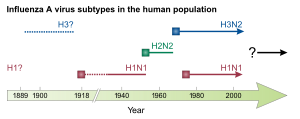 Image via Wikipedia
Image via Wikipedia
The H1N1 Spanish flu pandemic of 1918-1919 killed 500,000 in the United States (and as many as 50 million worldwide). The H3N2 Hong Kong flu pandemic of 1968-1969 killed 34,000 Americans (and approximately 700,000 worldwide). The H2N2 Asian flu pandemic of 1957-1958 killed 70,000 people in the United States (and approximately 2 million worldwide). Current average worldwide mortality from flu is estimated at between 250,000 and 500,000. Based on these statistics, the three pandemics and a typical flu season compare as follows:
Event………………………Mortality……………. Population……. Mortality/100,000….. % of population
1918-1919 Pandemic… 50,000,000……………. 1,800,000,000….. ……….2,778………………….. 2.78%
1957-1958 Pandemic….. 2,000,000……………. 2,946,827,264………………… 68…………………. 0.07%
1968-1969 Pandemic…….. 700,000……………. 3,561,750,111…………………. 20…………………. 0.02%
Current “typical” flu …250,000 to 500,000……6,790,062,216………… 3.7 to 7.4…………. 0.004% to 0.007%
Mortality, of course, is but one measure of a pandemic. I would guess that morbidity numbers among the three pandemics, if available, would show less variation due to differences in patient treatment, etc. Also, mortality and morbidity differences during a pandemic might tend to be more pronounced in more advanced healthcare settings.
![Reblog this post [with Zemanta]](http://img.zemanta.com/reblog_e.png?x-id=3e50625d-dc49-47d3-b11d-cc925936de26)